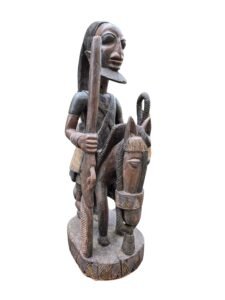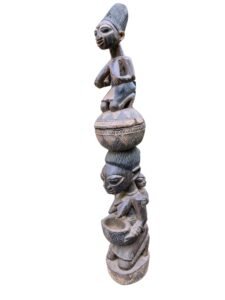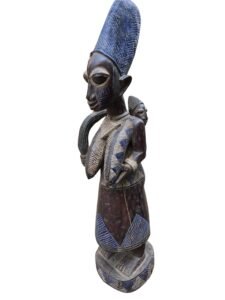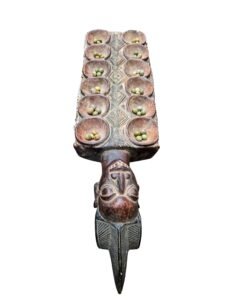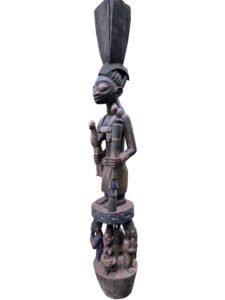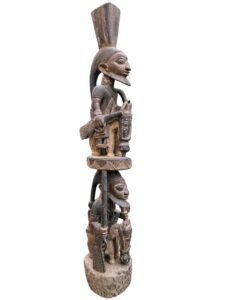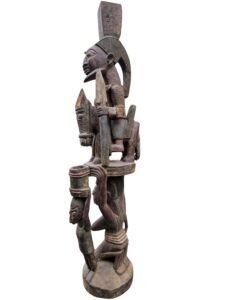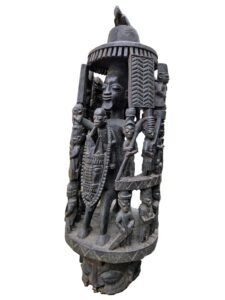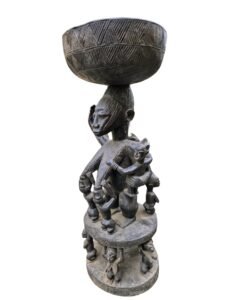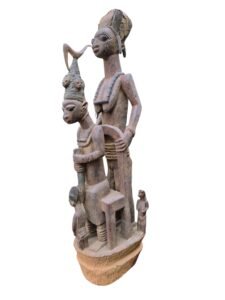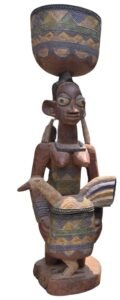Equestrian Ode to Yoruba Valor Olowe of Ise From a royal collection in Okemisi
This equestrian statue was carved from dense hardwood by Olowe of Ise, a
master Yoruba sculptor. It depicts a warrior riding a horse and holding a spear,
with intricate carvings highlighting his authority and strength.
The statue was likely used in royal courts, shrines, or ceremonies to honor
warriors, leaders, or ancestral figures. It served as a symbol of protection,
power, and leadership within the community.
This statue reflects the Yoruba cultural values of bravery, prestige, and
governance. In the Yoruba tradition, horses were rare and often associated with
royalty and military power. Such sculptures were displayed during important
events, reinforcing leadership roles and connecting communities to their
history.
Olumeye: Fertility Ritual Bowl, Olowe of Ise Collected from a Royal family in Osun State
This is a carved wooden ritual vessel by Olowe of Ise. It features a kneeling female figure known as Olumeye, “she who brings honor,” carrying an offering bowl and
carrying a kneeling fertility figure.
This ritual bowl is used in Yoruba religious ceremonies to hold offerings (ẹbọ) such as kola nuts, palm wine, or sacred herbs, presented to deities or ancestral spirits. In Yoruba culture, kneeling represents deep respect and devotion, and the Olumeye figure with the maiden atop the offering bowl symbolizes the sacred duty of carrying offerings for fertility and spiritual well-being and emphasizes the quest for fertility with the offering. The figure emphasizes motherhood's importance and the community's generational connection. These ritual practices have been passed down through
generations, ensuring the spiritual balance and continuation of ancestral traditions.
Maternity Figure: Olowe of Ise’s Priestess A Symphony of Line and Legacy From a private family collection in Ekiti
The maternity figure embodies Iya (motherhood) and depicts a woman carrying a child. This serves both a biological and spiritual role in Yoruba culture and symbolizes maternity and continuity. The child represents generational continuity, and its use was likely for ceremonial or ritual purposes, as indicated by its libation-worn patina.
Carved by Olowe of Ise in his characteristic geometric pattern and stylized forms, the sculpture explores a modernist approach, blending abstraction with
cultural symbolism. It features elongated proportions, geometric patterns like zigzag lines and concentric circles, and a polished surface from years of ritual use.
Ayo Opon Game Board.Olowe of Ise, Yoruba Cultural Artefact, From the Olowe Family collection
This Ayo Opon game board defines Olowe of Ise's style of intricate details and geometric patterns with a central human figure, which reflect Olowe of Ise’s
unmatched craftsmanship. Two opponents play this traditional Yoruba strategy game, which features twelve carved pits with forty-eight seeds.
Ayo Ọlọ́ pọ́ n, deeply embedded in Yoruba culture, is a two-player strategy game requiring tactical thinking and mathematical skill with players aiming to outmaneuver their opponents, each taking turns distributing and capturing seeds
and settled by the one who captures the most significant number of pits at the
end of the day.
A game more generally played today, it was historically enjoyed by Yoruba elites, including the Oba (king). The central carved figure representing a ruler or elder
underscores the game’s association with authority and governance and the character of Olowe of Ise’s commissions to royal courts.
Veranda Post Olowe of Ise A Yoruba Chronicle in Wood From a royal collection in Oyo state
The renowned Yoruba artist, Olowe of Ise, carved this veranda post (Opo Ile). It served
as structural support and a symbolic representation of leadership in Yoruba royal
palaces.
The post features a central female figure holding a bird and a staff, signifying wisdom,
spiritual power, and leadership. The elaborate headdress further emphasizes her high
status. Below her, multiple smaller figures support the structure, representing warriors
and attendants who embody protection, duty, and community.
In Yoruba culture, such veranda posts were installed in palaces to honor rulers and
reinforce their authority. The carvings depict the balance of power, spirituality, and
communal responsibility, reflecting the deep cultural values of leadership and
protection. These artworks were functional and central to Yoruba traditions, serving as
reminders of royal heritage and governance.
Olowe’s mastery is evident in the intricate details, dynamic composition, and lifelike
expressions, making this post a significant Yoruba artistic heritage.
A Hunter’s Honor Olowe of Ise’s Masterful Carving From a royal collection in Okemisi
This is a carved wooden veranda post by Olowe of Ise. It depicts a hunter in a
prominent position, sitting on horseback, holding a weapon, with a supporting
figure beneath him. The detailed carving, elongated forms, and geometric
patterns reflect Olowe’s signature style.
This veranda post was created for a Yoruba palace or shrine, serving both a
structural and symbolic role.
In Yoruba culture, hunters are deeply respected for their bravery, skill, and
connection to the spiritual world. They are associated with Ogun, the deity of
hunting and iron.
Hunters were revered figures, responsible for providing food and protecting the
community. This sculpture reflects their role as both protectors and providers and
reinforces the hunter’s high status in society while supporting the veranda’s roof. The
supporting figure beneath the hunter symbolizes the reliance on community and
tradition, emphasizing that individual strength is upheld by collective effort.
These veranda posts were part of daily palace life, maintained through rituals and offerings, ensuring that the values of courage and leadership were continuously
honored.
Veranda Post (Opo Ile). Carved by Olowe of Ise From a royal collection in Oyo State
This intricately carved wooden veranda post, created by the renowned Yoruba artist Olowe of Ise, was designed as a structural and symbolic element in a royal palace. The sculpture features a mounted warrior holding
a spear, supported by a female caryatid and an additional, more petite figure,
demonstrating a dynamic composition and expert craftsmanship.
Traditionally, this type of Opo Ile (veranda post) was installed in a Yoruba
king’s palace's exterior courtyard, serving as an architectural support and a
visual representation of authority, leadership, and historical legacy.
In Yoruba culture, veranda posts are essential in palace architecture,
symbolizing leadership, strength, power, hierarchy, and protection. They
demonstrate that a ruler’s strength comes not only from military might but
also from community support. As part of palace traditions, these posts
reinforce the ruler’s status while preserving history through visual
storytelling. Serving as visual records of Yoruba traditions, veranda posts pass down
stories of rulers and historical events. Over time, they have remained central to Yoruba
royal customs, reinforcing respect for authority and heritage.
Olowe Epa Mask Yoruba Cultural Artifact (Ekiti, Nigeria) Collected from a Royal collection in Kogi State
This intricately carved Olowe epa mask was carved from a single piece of
durable hardwood, which is the Olowe tradition, with a textured surface and
geometric patterns, recognizable elements of Olowe’s mastery. The mask
embodies profound cultural and spiritual symbolism. Dominated by a
prominent central figure often interpreted as a leader or deity, represents
strength and authority with ancestral connection. It is flanked by more
miniature attendant figures, symbolizing collective support and societal
cohesion. The composition emphasizes hierarchy and communal unity.
Linked to the annual epa festival, an annual ceremony held in Southwest
Nigeria, usually in the months of February or March, but can occur as late as
September in some areas, performers wear these masks in vibrant
masquerades that blend dance, music, and storytelling, invoking ancestral
blessings and commemorating historical resilience, to honor their gods and ensure the well-being and fertility of the community and connecting the present
generation to their heritage.
Afo Maternity Statue with Offering Bowl Olowe of Ise, Yoruba Cultural Artifact From a royal collection in Okemisi
This sculpture exemplifies Olowe of Ise’s artistic genius, blending aesthetic beauty with deep spiritual meaning in Yoruba religious and cultural life.
This is a maternity statue with an offering bowl. Multiple children are carved around the central figure to symbolize blessings, fertility, abundance, lineage, communal responsibility, and divine favor granted to those who honor their ancestors and deities.
In Yoruba culture, many children signify wealth, prestige, and ancestral continuity. It also reflects the role of women as caregivers and the importance of extended family structures. The detailed carvings highlight Olowe’s skill and artistic style, and this sculpture.
The statue was used in rituals and ceremonies, holding kola nuts, herbs, or other sacred offerings. It played a role in prayers, blessings, and spiritual practices, placed in shrines or communal spaces.
Olowe of Ise’s Veranda Post. A Masterpiece of Yoruba Art and Royal Authority From the collection of the Oba of Ojodu, Alh. Chief Mojimudeen Lamidi Aro Abore 1 Featured in the Olowe documentary
This carved wooden veranda post, created by Olowe of Ise, a renowned Yoruba artist from Ise, Ekiti State, Nigeria, was commissioned for the palace of the Ogoga of Ikere. Crafted in Olowe’s signature style, it features an elongated figure, dynamic compositions, and intricate detailing, combining form and function.
This post features a seated king, his senior wife, and attendants, emphasizing the ruler’s elevated status. The king’s feet do not touch the ground, symbolizing his
sacred nature, while his towering wife represents wisdom and protection.
It served a dual purpose: structural support for the palace veranda and a powerful visual statement of the king’s divine authority.
Olumeye Ritual Bearer Yoruba Spiritual Artifact Olowe of Ise From a royal collection in Okemisi
The bowl is the Olumeye, named for the female figure, "one who knows honor," that serves as a messenger to the spirits. It is carved from a single hardwood and features a kneeling figure, often a female Yoruba figure, except for royalty
carrying a bowl on the head and holding a container with a bird motif, both adorned with intricate carvings and patterns.
The Olumeye plays a key role in rituals; the bowl holds ritual items such as food, herbs, or symbolic objects used in spiritual rites and ancestral veneration. Carrying offerings symbolizes a community’s prayers, gratitude, and connection to the divine. Such figures are central to Yoruba festivals, reinforcing continuity between past and present traditions.
Veranda Post A Masterpiece of Yoruba Art and Royal Authority From the collection of the Oba of Ojodu, Alh. Chief Mojimudeen Lamidi Aro Abore 1
This carved wooden veranda post, created by Olowe of Ise, a renowned Yoruba
artist from Ise, Ekiti State, Nigeria, was commissioned for the palace of the
Ogoga of Ikere. Crafted in Olowe’s signature style, it features an elongated
figure, dynamic compositions, and intricate detailing, combining form and
function.
This post features a seated king, his senior wife, and attendants, emphasizing
the ruler’s elevated status. The king’s feet do not touch the ground, symbolizing
his sacred nature, while his towering wife represents wisdom and protection.
It served a dual purpose: structural support for the palace veranda and a powerful visual statement of the king’s divine authority.
